anchor
What's around my desk
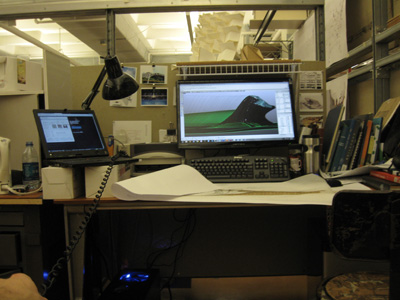
Thesis is an atmosphere. It's a condition you inhabit, with its own climate system and rules of physics. The beauty and the death of this atmosphere lies in the fact that it's
you who is in control. Only you get to say "yes, this belongs here" or "no, I will ignore that." You define the boundaries. But like any atmospheric condition there are limits, a (fuzzy) edge where the rules of the particular model cease to apply, and an outsideness threatens to invade. Sometimes that is a good thing; it is a necessary thing--a thesis project exists and must be tested in a "real" world, even if that world is fully enclosed in an academic setting. But there are times when you want to say "no, no, no, go away, go the &$ away", put on your headphones and dive into the depths of a model that you dreamt about the previous night. The slightest cell phone vibration makes you mad as hell, as that impermeable thesis bubble is so hard to maintain.
And then there is the inevitable moment, when you have to bring the thing out of your atmosphere to see if it can breathe another kind of air. We call that the design review.
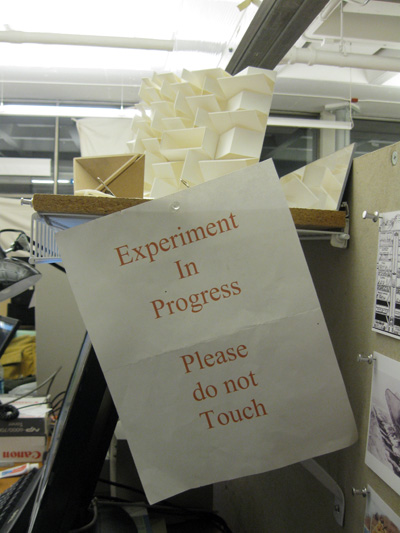
When I moved into my desk here on the 9th floor of Wurster Hall last month, this 8 1/2 by 11 was pinned to a shelf with someone's laser-cut detritus from last semester threatening to sprout legs and crawl away. I let the chipboard creature loose, but kept the sign. Wursterites, heed the warning.
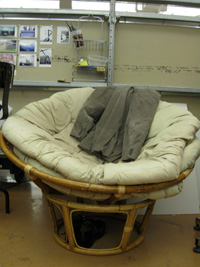
[But that doesn't mean you shouldn't drop by my desk and have a seat at the papasan behind my chair. All are welcome.]
So I think the best way to catch readers up to what I'm doing is introduce them into my atmosphere. I'll make this post lite on the txt, and let the images ride.
some precedents:

[above left, a decommissioned "elephant cage" antennae array I visited on Guam; above right, retaining wall construction that I saw in Okinawa, common in Japan; bottom left, the F-35, the noise of which is the generator of my form; bottom right, the world's largest anechoic chamber which I will be visiting in March]

[Nervi, Environmental Acoustics, and Land Art]
Books, books... thesis is full of turning pages, reading snippets of things, with always the risk of diving into a chapter that will end up having nothing to do with your project. But you have to take that risk. Other books I am currently reading for thesis are:
Sonic Warfare, The Soundscape of Modernity, David Gissen's
Subnature, and Foucault's
Security, Territory, Population.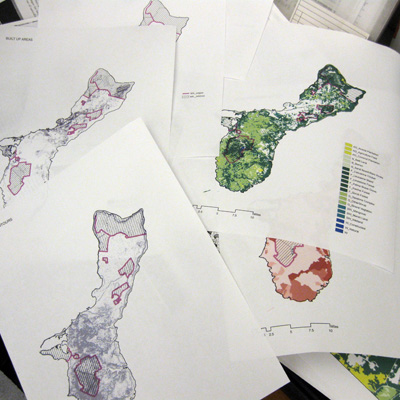
[GIS-maps of Guam]
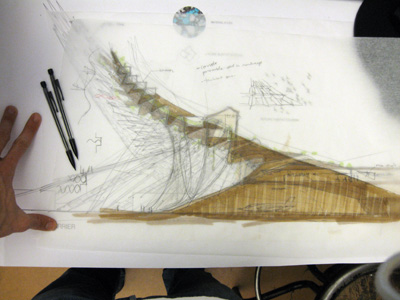
Working in section is the most important thing right now. This is a cross-section of a noise barrier which will reduce the jet sound and provide some inhabitable space. This is where the argument of my thesis will be tested: if the US military is to continue building global bases, they need to incorporate a mechanism for demilitarization into the fabric of the base itself. That mechanism must occur at the contested territory at the edge of the base, which I have sought to amplify by attenuating jet noise. The form is comprised of a berm and a cantilevered, porous wall.
It's probably been two years since I busted out the prismacolor markers, thank you thesis for that.

[a CNC-milled foam model demonstrating a gradient of noise absorptive geometry]

[gotta survive]
What's around
your desk?













6 Comments
Nick,
How are you liking "Sonic Warfare" by Goodman? Are you a fan at all of his non-academic output. Meaning his music as Kode9 or the various music put out by his label Hyperdub?
I have been a huge fan for a couple of years now. Takes me back to my raving days...
Nick,
great stuff...
I am designing under an interstate and am playing with psycho-acoustics and the like right now as well.
I used a program called sigview for spectral signal processing and was wondering what software you used to point at your form to attenuate the jet sound - thats a good looking section.
nam, it's a good book--gets you thinking about sound in ways that don't involve just hearing it. I haven't heard his music yet. Maybe it's better if I just imagine what it would sound like.
awkeytect, thanks for the comments! I'm going to be using some expensive German software, can't remember the name right now, that a SF acoustic design firm uses, to model the sound of the jet and the performance of my barrier. It's only going to be good for the large scale though. If I get down to the finer scale I'll need another program to run the raytracing.
Is the spectral data specific to your project or are you just looking at attenuating the overall noise level? I'm interested in allowing certain parts of the audio spectrum through the structure.
Nick! Thanks for the peek into your universe.
I have the same starbucks mug as you. Unfortunately 'to-go' mugs are not recognized as viable containers for liquids here in Denmark. Meaning that when I try to get coffee in it at the cantine here, either the cashier doesn't realise that it's coffee (free!) or charges me thrice the normal rate. Excellent.
your first paragraph.
i haven't experienced that in awhile. very saddened and confused by this fact. thanks for reminding me how awesome it is.
Block this user
Are you sure you want to block this user and hide all related comments throughout the site?
Archinect
This is your first comment on Archinect. Your comment will be visible once approved.